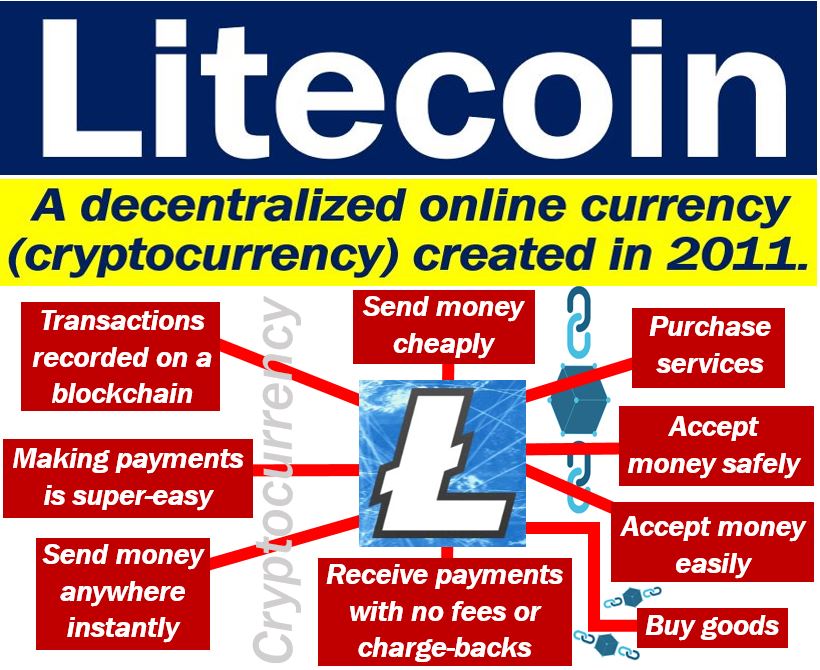Litecoin is a peer-to-peer cryptocurrency, i.e., digital currency, and also an open software project. It uses an open-source cryptographic protocol to create and transfer coins. The whole system has no central authority managing it. Cryptocurrency experts say that technically it is almost identical to Bitcoin. With Litecoin, people can pay money to anyone in the world instantly at near-zero cost.
Mathematical algorithms secure the network, which empowers users to control their own finances.
However, Litecoin, unlike Bitcoin, concentrates on using the latest technology to enhance user experience and improve performance.

Litecoin – a cryptocurrency
Litecoin is a cryptocurrency that has existed since 2011. Cryptocurrencies first went into circulation in 2009. So, what is a cryptocurrency?
A cryptocurrency is a kind of money that exists electronically, i.e., digital money. Cryptocurrency creators designed them to be super-secure, and in most cases, also anonymous.
In other words, people can use cryptocurrencies to buy and sell things without revealing their identities.
The word ‘cryptocurrency’ is a combination of ‘crypto’ and ‘currency.’
– Crypto is short for cryptography, i.e., the art of making codes and also deciphering them.
– A currency is a type of money, such as the dollar, pound, euro, etc., that a country uses. Currency may sometimes mean banknotes and coins when we are talking about the money supply.
The creators of cryptocurrencies used encryption techniques to regulate the generation of new currency units. ‘Encryption techniques’ means sophisticated codes. Their encryption techniques also validate and verify the transfer of funds.
Unlike the dollar, yen, euro, pound, rupee, and yuan, cryptocurrencies have no central bank regulating them.
All cryptocurrencies except for Bitcoin are Altcoins. Altcoin stands for for ‘alternative coin.’ Therefore, Litecoin is an Altcoin.
You cannot buy, sell, or store cryptocurrencies without a cryptocurrency wallet. The wallet also keeps a record of all transactions and tells you what your balance is.
Litecoin vs. Bitcoin
Former Google engineer Charles Lee created the Litecoin digital currency and electronic payment system. It appears on exchanges under the symbols XLT or LTC.
It is, like Bitcoin, a decentralized system that uses distributed ledger technology and blockchains.
However, Bitcoin takes considerably longer to generate a block.
Regarding the two cryptocurrencies’ capabilities, PC Mag says:
“Litecoin’s fixed maximum is 84 million coins rather than Bitcoin’s 21 million.”
What is a blockchain?
It is through the blockchain that cryptocurrency transactions are validated, and their data is stored. A blockchain is an ever-growing list of blocks or records which are linked and secured thanks to cryptography.
Each block usually has a hash pointer as a link to the block that preceded it. It also contains transaction data and a timestamp.
The cryptocurrency creators designed the blockchains to be completely resistant to modification.
On its website, Webopedia makes the following comment regarding blockchains:
“Blockchain refers to a type of data structure that enables identifying and tracking transactions digitally and sharing this information across a distributed network of computers, creating in a sense a distributed trust network.”
“The distributed ledger technology offered by blockchain provides a transparent and secure means for tracking the ownership and transfer of assets.”
We call the computers that link to the blockchain network nodes.
Smart contracts
In a typical blockchain, there are what we call smart contracts, i.e., lines of computer code. Thanks to the lines of code, these digital contracts are fully-automatic.
In other words they are totally self-executing contracts that require no intermediaries such as lawyers or notaries.
